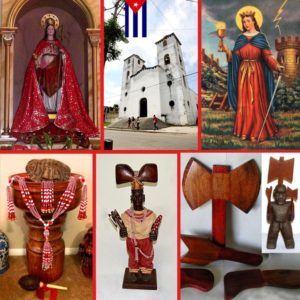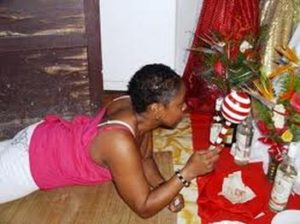CHANGÓ Y SANTA BÁRBARA BENDITA EN EL PANTEÓN YORUBA.
Changó en el sincretismo se compara con Santa Bárbara y también tiene su fiesta el 4 de Diciembre, según al calendario santoral católico.
Santa Bárbara fue una virgen y mártir cristiana del siglo III, forma parte de la lista oficial del martirologio de la Iglesia Católica y según el calendario o santoral católico su fiesta se celebra el 4 de diciembre.
Se le suele representar bien con la palma del martirio o bien con plumas de pavo real, pues este animal es símbolo de la resurrección o la inmortalidad, y aparece ya en la más antigua representación conocida, que data del siglo VIII en Santa María la Antigua, de Roma.
En la imagen más conocida en nuestro país suele aparecer con su atributo: una torre con tres ventanas y en otras, la torre aparece a su lado o en miniatura sobre una de sus manos. El significado de esta torre con tres ventanas es el refugio de la fe en la Santísima Trinidad. Suele llevar corona, que admite variaciones: en algunas es la de una princesa y en otras es una corona completa formada de varias torres.
La imagen de santa Bárbara también aparece a veces asociada con la espada con la cual fue decapitada, lo que ha contribuido a que sea asociada con la guerra, pero dicha espada representa un símbolo de fe inquebrantable y con un cáliz, que significa su conversión al catolicismo.
El rayo que cayó en su martirio ha hecho que sea relacionada con los explosivos y así es patrona del arma de artillería, cuyo escudo son cañones cruzados y la torre es la heráldica de los ingenieros y zapadores. El depósito de explosivos en los buques recibe el nombre de Santabárbara.
En ocasiones lleva una rama de olivo entre sus manos, representando el martirio. Pero siempre con su manto rojo, cáliz de la sangre de Cristo.
Es la patrona de las profesiones que manejan explosivos, debido a la leyenda del rayo, y especialmente de los militares que pertenecen al arma de artillería en la mayoría de los ejércitos, incluso en algunos países musulmanes. En las cuencas mineras asturianas le dedican un himno llamado “Santa Bárbara bendita”, por ser patrona de los mineros. También es la patrona de los electricistas. Igualmente es la patrona de los feriantes.
Es clásico el patronazgo que ejerce de los canteros. Por ello en alguna iconografía aparece su figura junto a bloques de piedra. Es patrona también de los arquitectos.
En Cuba la popular iglesia de Santa Bárbara se encuentra en el barrio de Párraga, municipio de Arroyo Naranjo. Allí no solamente van sus fieles de religión católica, sino también frecuentan los devotos de Shangó, de la religión yoruba.
Changó o Shangó (en yoruba, Ṣàngó ) es un dios de la religión yoruba. Shangó en el sincretismo se compara con Santa Bárbara, la cual tiene su fiesta el 4 de Diciembre, de acuerdo al calendario santoral católico. Su día de la semana es el sábado, aunque el viernes también es popular. Su número es el 6 y sus múltiplos, aunque algunos le adjudican el 4, quizás por su sincretismo religioso con Santa Bárbara. Sus colores son el rojo y blanco y su collar también es de cuentas de ese color. Se saluda ¡Kaó Kabiesilé, Shango Alufina!
Shangó es uno de los más populares Orishas del panteón Yoruba. Es considerado Orisha de los truenos, los rayos, la justicia, la virilidad, la danza y el fuego. Shango es un Osha guerrero, el rey de la religión Yoruba y uno de los Orishas más populares de su panteón. Shango es un Osha y está en el grupo de los Oshas de cabecera.
Orisha de la justicia, la danza, la fuerza viril, los truenos, los rayos y el fuego, dueño de los tambores Batá, Wemileres, Ilú Batá o Bembés, del baile y la música; representa la necesidad y la alegría de vivir, la intensidad de la vida, la belleza masculina, la pasión, la inteligencia y las riquezas. Es el dueño del sistema religioso de Osha-Ifá.
Orisha de la justicia, la danza y la fuerza viril, dueño de los tambores Batá, Wemileres, Ilú Batá o Bembés, del baile y la música; representa la necesidad y la alegría de vivir, la intensidad de la vida, la belleza masculina, la pasión, la inteligencia y las riquezas.
A Shangó se le ofrenda amalá hecha a base de harina de maíz, leche y quimbombó, plátanos verdes, otí, plátano indio, vino tinto, maíz tostado, cebada, alpiste, etc. Se le inmolan carneros, gallos, codornices, jicotea (tortuga de río), gallina de guinea, palomas, etc. Sus ewe son el bledo punzó, atiponlá, platanillo de Cuba, Ceiba, paraíso, cedro, álamo, baría, zarzaparilla, bejuco carey, bejuco colorado, almácigo, camagua, combustera cimarrona, caña de azúcar, cebolla, caoba, flamboyán, guano blanco, guano prieto, laurel, maíz, palo amargo, mamey colorado, palo boma, hierba jicotea, piñón, piñón botija, quimbombó, rompesaragüey, ruda, tomate, travesera, yaya, palma, peonía, hierbabuena, trébol, canistel, filigrama, yaba, etc.
Y para terminar, una oración:
Changó, padre mío!
Mírame…
Protégeme.
Alejad los malos y traed la alegría para mí y para los míos.
Recuerda que yo soy tu hijo y que tú eres el dueño de mi casa.
Te pido que nos alcances tus dones
y que nos socorras para solucionar nuestros problemas.
Señor, señor de mi casa.
Gracias a ti, glorioso y elevado ser.
Agencies/CubaMemorias/DerubinJacome/InternetPhotos/ArnoldoVarona/TheCubanHistory.com
THE CUBAN HISTORY, HOLLYWOOD.
CHANGÓ AND SANTA BÁRBARA BENDITA IN THE YORUBA PANTHEON.
Changó the syncretism is compared to Santa Barbara and also has its own festival December 4, according to the Catholic Saints calendar.
Santa Barbara was a Virgin Christian martyr of the 3rd century, form part of the official list of the martyrology of the Roman-Catholic Church and according to the timetable or Catholic Saints his feast is celebrated on 4 December
Usually you represent well the Palm of martyrdom or with peacock feathers, because this animal is a symbol of the resurrection or immortality, and appears in most ancient representation known, dating back to the 8th century in Santa María la Antigua, in Rome.
In the better known in our country image often appears with its attribute: a tower with three windows, and in others, the Tower appears at his side or thumbnail on one of his hands. The meaning of this tower with three windows is the refuge of the faith in the Holy Trinity. Usually bring Crown, which supports variations: in some it is the of a Princess and others is a full Crown formed of several towers.
The image of santa Barbara also appears sometimes associated with the sword with which was beheaded, which has contributed to be associated with the war, but the sword represents a symbol of unwavering faith and a chalice, which means his conversion to Catholicism.
Beam that fell in his martyrdom has done that it is related to explosives is Patron Saint of the weapon of artillery, whose coat of arms are crossed cannons and the tower is the Heraldry of Sappers and engineers. The deposit of explosives on vessels called Santabarbara.
Sometimes carries a branch of olive in her hands, representing the martyrdom. But always with her red robe, chalice of Christ’s blood.
He is the patron saint of the professions that handle explosives, due to the legend of Ray, and especially the military belonging to the weapon of artillery in most armies, even in some Muslim countries. In the Asturian coalfields, they dedicate a hymn called “Santa Bárbara bendita”, as Patron Saint of miners. He is also the patron saint of electricians. He is also the patron saint of the Showmen.
It is classic patronage that acts as the Quarrymen. Therefore any iconography appears his figure next to stone blocks. He is Patron Saint also of architects.
In Cuba the popular church of Santa Barbara is located in the neighborhood of Parraga, municipality of Arroyo Naranjo. There are not only the faithful of the Catholic religion, but also frequent the devotees of Shango, the yoruba religion.
Chango or Shango (in yoruba, Ṣango) is a God of the yoruba religion. Shango the syncretism is compared to Santa Barbara, which has its own festival December 4, according to the calendar Catholic Saints. The day of the week is Saturday, but Friday is also popular. Their number is 6 and its multiples, although some pay 4, perhaps by its religious syncretism with Santa Barbara. Their colors are red and white and collar is also accounts of that color. Greets Kaó Kabiesilé, Shango Alufina!
Shango is one of the most popular Orisha of the Yoruba pantheon. It is considered Orisha of Thunder, lightning, justice, virility, dance and fire. Shango is a warrior Osha, the King of the Yoruba religion and one of the most popular Orisha of their pantheon. Shango is an Osha and header Oshas group.
Orisha of Justice, dance, virile strength, Thunder, lightning and fire, owner of the drums beat, Wemileres, Ilú Batá or Bembe, of dance and music; It represents the need and the joy of living, the intensity of life, male beauty, passion, intelligence and wealth. He is the owner of Osha-Ifa religious system.
Orisha of Justice, dance and virile strength, owner of the drums beat, Wemileres, Ilú Batá or Bembe, of dance and music; It represents the need and the joy of living, the intensity of life, male beauty, passion, intelligence and wealth.
Offering Shango Amal made out of flour of corn, milk and okra, plantains, oti, Indian plantain, red wine, roasted corn, barley, Canary seed, etc. He immolated Rams, Cockfighting, quail, turtle (turtle River), guinea fowl, pigeons, etc. Your ewe are the damn ponceau, atiponlá, platanillo of Cuba, Ceiba, paradise, cedar, poplar, baria, sarsaparilla, bejuco carey, bejuco colorado, nursery, camagua, cimarrona combustera, sugarcane, onion, mahogany, flamboyan, white guano, prieto guano, laurel, corn, bitter, mamey palo colorado, palo boma, herb jicotea, sprocket, sprocket botija, okra, rompesaragüey, ruda, tomato, travesera, yaya, Peony, peppermint, clover, canistel, filigrama, yaba, etc.
And finally, a prayer:
Chango, my father!
Look at me…
Protect me.
Away the bad guys and bring joy for me and mine.
Remember that I am your son and that you are the owner of my house.
I ask that we reaches your gifts
and we socorras to solve our problems.
Lord, Lord of my house.
Thank you, glorious and high to be.
Agencies/CubaMemorias/DerubinJacome/InternetPhotos/ArnoldoVarona/TheCubanHistory.com
THE CUBAN HISTORY, HOLLYWOOD.









